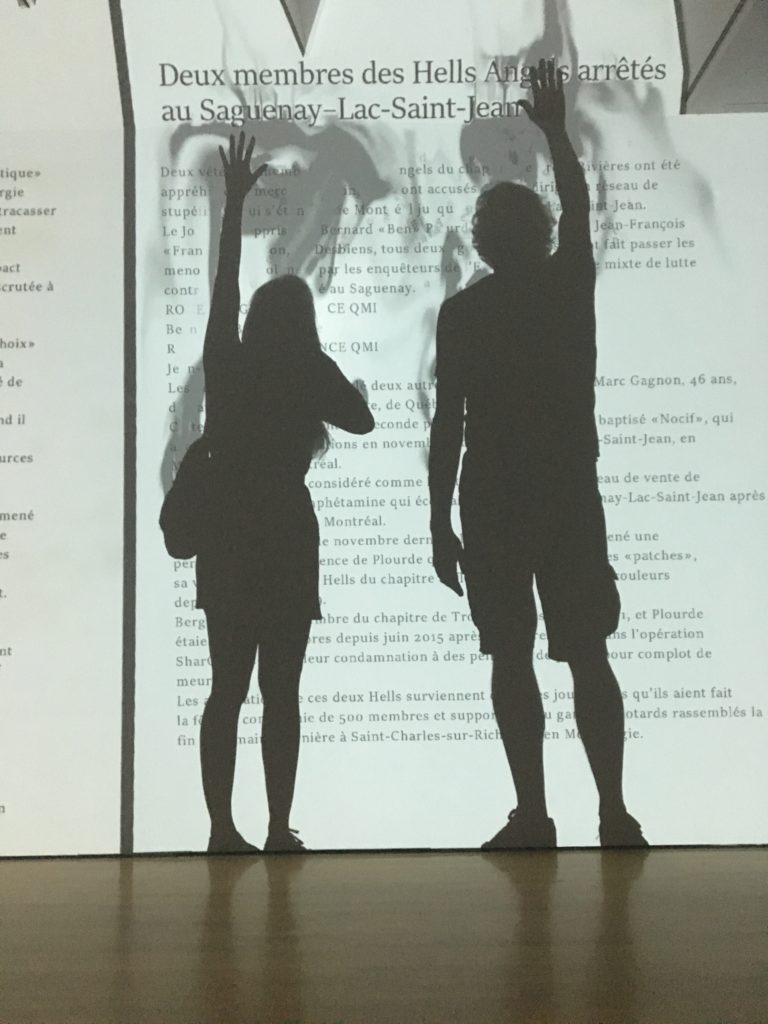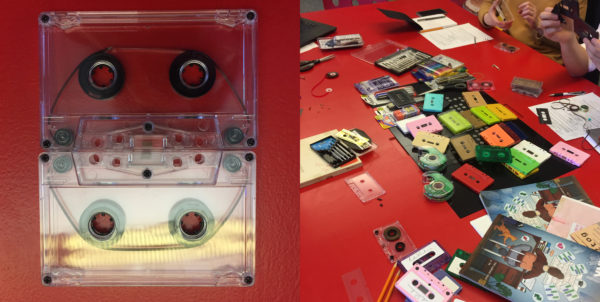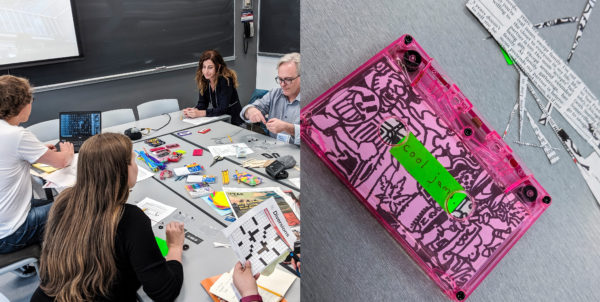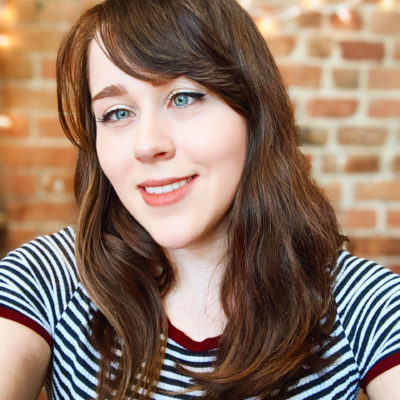“Immersive Media” and the Phenomenological Experience of Listening: A Conversation with Deanna Fong and Jon Saklofske
November 20, 2020
Ali Barillaro


Venturing outside our own research comfort zones can be an intimidating journey. But as postdoctoral fellow, and longtime SpokenWeb researcher, Deanna Fong (Concordia University) and professor Jon Saklofske (Acadia University) have discovered, conversation and collaboration can offer truly productive pathways toward new and exciting research questions and practices. At the centre of their most recent project are the sounds of Ninja Theory’s acclaimed 2017 game, Hellblade: Senua’s Sacrifice. Initially drawn to Deanna and Jon’s proposal as a video game enthusiast, when I sat down to draft some questions, I found I was as curious to hear about how their partnership began and how it has progressed over the past few months, as I was to hear about their take on Hellblade.
As a fellow member of the SpokenWeb team, I’m already familiar with you and some of your recent work, Deanna, but I don’t yet know the story behind what brought you and Jon together as researchers to pursue the work you intend to present at the Symposium. Can you talk a bit about how this collaboration came to be?
Our collaboration began with a shared love of cassette tapes—their aesthetics and affordances. We did quite a bit of media “crafting” on the side of our other academic work, making mix tapes, cassette books, and tape loops. In fact, Jon actually turned a tape into a miniature projector that casts the text of a Robert Creeley poem on the wall at the push of a button! After playing around with these projects for awhile, we decided to bring this experimentation into the classroom by offering a workshop, “Remixing Compact Cassette Technology” at the TAG Research Centre in the spring of 2019.
This paved the way for a slew of conversations about the materiality of sound, voiced poetry and poetics, and experiential media, and we started to think of ways that we could bring our research interests together. Jon had just finished editing the collection Feminist Wargames? Mechanisms of War, Feminist Values, and Interventional Games (Routledge 2020), which (as the title suggests) intersects ludic media and feminist politics. I had just finished my dissertation on auditory media, the event of listening and its contingent ethics. We decided that the best way to bring our spheres of knowledge into conversation would be to analyze sound production in video games, with an eye (ear?) towards the assumptions that underpin the medium, its subordination of sound to visuality, and the ways that sound can disrupt the biases inherent in game design when it is made a deliberate experiential component.
 “Remixing Compact Cassette Technology” 2019
“Remixing Compact Cassette Technology” 2019
 “Unnatural Resonance: Revisualizing and Defamiliarizing Compact Cassette Technology” 2019
“Unnatural Resonance: Revisualizing and Defamiliarizing Compact Cassette Technology” 2019
I’ve just realized that I’ve actually met Jon before! I was circulating between a trio of workshops at the 2019 SpokenWeb conference in Vancouver documenting as many of the events as possible while Jon was leading “Unnatural Resonance: Revisualizing and Defamiliarizing Compact Cassette Technology”. I sadly didn’t get the full workshop experience, but I was invited to join the group once I had finished snapping some pictures and I had a blast unmaking and remaking my own cassette tape. [I still keep it on display in my living room]. It’s wonderful that you’ve found and developed these new points of connection between your personal research interests! You mentioned in our initial correspondence that your work is still in its preliminary stages, but could you give a bit of a teaser for your planned presentation for the conference?
Oh, that’s a wonderful stroke of serendipity! Yeah, I think we both have tape display cases at this point, too. We’re always thinking of the affordances of the cassette tape as a problem to be solved, like: Could you make two cassettes share the same magnetic tape? Could you install the tape head into something that’s not a tape and make it play? Could you turn a tape into a scroll? Every little victory in research and development becomes a trophy for the case.
We’re trying to bring this sense of play into the new research that we’re planning to present at the conference as well. Conceptually, we’re looking forward to talking about the importance of mediated sound in the context of multimedia/multimodal experiences, and engaging with the phenomenological experience of listening in relation to “immersive media” (such as video games). What intrigues us is the meaning potential of experiences that are not predicated upon auditory verisimilitude and which disrupt sonic localisation in disorienting, but illuminating ways. Using a Nintendo Switch version of the game, we’re also planning to engage with the meaningful complexities related to the operations of spatial sound, binaural recording and playback, and the disorientation caused by sound design that plays with (or defies) spatial logics. As a teaser, our presentation plans to demonstrate these dynamics by inviting audience participants to play through curated moments of the fantasy action-adventure game Hellblade: Senua’s Sacrifice.
That’s a great idea! I’ve attended a few talks about video games in the past and it’s always a bit of a challenge to fully grasp the researcher’s arguments about the gameplay with only stills or video excerpts on hand. And if you’re looking for willing test players I’m ready to volunteer! Given how much life has changed this year, have you been able to continue your work together as intended or have you found yourselves adapting and evolving your scope and/or methodology as you go?
Since we live in different provinces, it’s kind of business as usual. We were planning on using the conference as a milestone for our research and to get together in-person, but we have had to divert and think of different ways of working together, in tandem and individually. While this has produced a slight delay in the project, our enthusiasm hasn’t been affected at all, and the scope of the project is—if anything—continuing to expand beyond our initial queries!
Though not having played it myself, after looking into the game at the centre of this research (Hellblade: Senua’s Sacrifice) I understand the game developers carefully considered the voice acting and sound production in order to reflect the character’s sonic experience of psychosis. It seems there are different editions of Hellblade allowing you to play with or without a VR system, so I’m wondering what you’ve discovered so far in regards to how the more immersive experience of virtual reality impacts the player’s perception of elements of the soundscape as hallucinatory?
We’ve experienced Hellblade on Playstation 4, the Nintendo Switch, and a non-VR PC so far, and are hoping to extend our explorations to the VR experience of this game very soon. While the non-VR versions are already quite powerful in terms of their aural impact, it will be interesting to compare how an immersive visual field changes the experience of the game’s aspatial and non-localisable sound layers, especially since the non-VR version of the game already highlights the disjunction between a player’s limited field of vision and the 360-degree sonic environment.
Some initial critical reactions to the VR experience of the game indicate the promise of comparatively focusing on this experience from the perspective of sound studies, and we’re excited by the ways that this game already challenges some of the expectations related to the experience of sound in a VR environment. Positional sound adjustment attaches sound to space, and in VR this is incredibly noticeable and effective: in all VR experiences sounds are localized to specific anchors in the rendered environment, meaning that the experience of the sound changes relative to a player’s position and directionality in the virtual space. But the internal voices in Hellblade are non-objective, in that they don’t reference an external object; yet they coexist in the soundscape of the game with sounds that are localisable to the game’s spaces. We’re curious to see if this juxtaposition would amplify the effect of the binaural dislocation and how this might further illuminate the meaning potential and function of aspatial sound features in presence-based media experiences.
Aside from exploring Hellblade’s soundscape, what most excites each of you about your research right now and what else have you been up to?
Jon: I’m excited about the ways that contemporary media experiences necessitate multiple literacies while also defying some of those traditional habits of theorizing and understanding. I think that there’s room to make significant progress toward a deeper and more comprehensive understanding of the complexity of human experience via the humanities “labs” of games and virtual worlds—and sound is an often-neglected but essential aspect of such work. As well, I’m interested in the ways that this kind of scholarly work intersects with the idea of values-based media and experience design, and the responsibility that designers of such experiences have to lucidly recognize, identify, and overcome particular biases, assumptions, and perceptual and ideological habits in their work. I’m also insanely excited to be working with Deanna because I so intensely respect the sophistication and humanistic compassion that she brings to bear on research questions and scholarly communication.
Deanna: I’m actually excited to be playing video games! Honestly, it’s pretty far outside of my comfort zone in terms of my own media literacy. I think the last video game I played myself was Final Fantasy III… on the Super Nintendo. That said, I’m delighted and maybe even a little giddy to come at questions of narrative, agency, and even metaphysics through the experience of gaming. Like, it’s a real paradigm shift for me. I think it’s important to take risks in our research and to go places we normally wouldn’t go—obviously not in terms of ethics or anything like that, but to challenge ourselves to reach beyond our particular disciplines, methods, or ways of thinking. Jon is totally like that: he’s a Romanticist who does Games Studies, Electronic Literature, and Digital Humanities… He somehow manages to be everywhere at once. I’m always impressed with his enthusiastic and rhizomatic approach to scholarship—putting William Blake into conversation with Mass Effect; seeing the angles and connections that most people miss.
Finally, because we’re always curious to know, what are you listening to these days and are there any recordings you’d like to share with our readers?
Jon: Omigod yes. “The Ending of Dramamine” by Car Seat Headrest is a song that I stumbled across a few weeks ago and can’t stop listening to. Its unexpectedness and the intense emotionality of its unique sonic configurations affect me profoundly. I know that this reaction will dissipate as I keep listening to it and become overfamiliar with its patterns, but for now, that mix of aural novelty, the melancholy poetry of its lyrics, and the way that it functions as a familiar surprise (like a best friend or favourite food) is more powerful than anything else I’m currently experiencing. It reminds me that I can still feel deeply at a time when so much human life and interaction is muffled and masked…
Deanna: I just did an interview with the inimitable Tracie Morris for an edited collection, Resistant Practices in Communities of Sound, that my colleague Cole Mash and I are working on, so I was dipping back into her incredible repertoire of sound poetry in the past few weeks. Her “hand-holding” improvisation with Kurt Schwitters’ “Ursonate,” generatively titled “Re-Sonate,” is one of my absolute favourites, but the one that got it all started for me was “A Little,” which I first heard in Sina Queyras’ grad poetry workshop, and which still knocks me to the floor every time
Deanna Fong is a Postdoctoral Fellow in English and History at Concordia University, where her research focuses on the ethics of listening in the context of literary audio. She has been a member of the SpokenWeb team since 2010, and co-directs the Fred Wah Digital Archive. With Karis Shearer, she recently co-edited Wanting Everything: The Collected Works of Gladys Hindmarch (Talonbooks, 2020).
Jon Saklofske, a Literature Professor at Acadia University, is insatiably curious about intersections between media forms and cultural perceptions. In addition to experimenting with virtual environments and games as tools for academic research, communication and pedagogy, Jon’s other research interests include environmental storytelling in theme parks, values-based game design, alternative platforms for open social scholarship, and the critical potential of feminist war games.
This article is published as part of the Listening, Sound, Agency Forum which presents profiles, interviews, and other materials featuring the research and interests of future participants in the 2021 SpokenWeb symposium. This series of articles provides a space for dialogical and multimedia exchange on topics from the fields of literature and sound studies, and serves as a prelude to the live conference.
